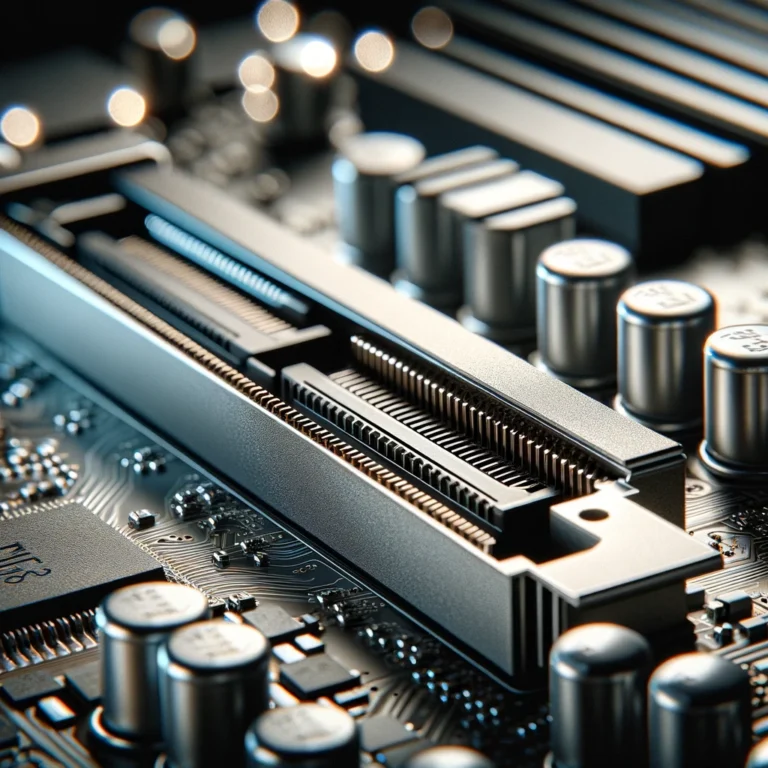6 Game room paint ideas
6 Game room paint ideas
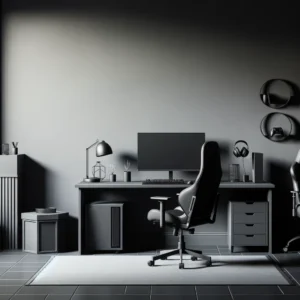
Hey, fellow gamers, it’s time to talk about something that can level up your gaming space—paint colors! As a pro gamer, I’ve experimented with my setup and discovered that the right color can boost your mood and improve your gaming setup. So, let’s dive into some fantastic ideas to help you choose the perfect hue for your game room.
Table of Contents
Why Color Matters in Your Gaming Room
Choosing the right colors for your gamer room isn’t just about aesthetics—it’s about creating an environment that enhances your playful atmosphere, influences your mood, and supports the functionality of your living space. Let’s break down why color is so crucial:
The Impact of Color Psychology
Colors do more than decorate a space; they profoundly affect our emotions and behavior. For instance, specific colors can increase alertness, improve concentration, or help you relax. I initially went with a vibrant orange when setting up my game room. While it looked energizing, it was overwhelming during marathon sessions. Switching to a calming blue helped maintain my focus and calm me during intense gaming battles. This is because blue is known for its calming effects on the mind, promoting mental clarity and reducing stress.
Enhancing Gaming Performance
The right color can boost your gaming performance. Darker shades reduce glare on your screens, which is a lifesaver during long hours of play. Plus, specific colors like green or blue can decrease eye strain, essential when staring at a screen for extended periods. I remember a friend who painted his room a soft matte green and said it reduced his eye fatigue during late-night gaming sessions. A great game room design can set the stage for those long game nights. Having a good gaming area with a decent or best gaming setup won’t take back any game night.
Setting the Lively Atmosphere
Your game room is your retreat, and its color should reflect the type of games you enjoy and the atmosphere you want to create. For example, immersive RPG gamers might prefer darker, richer colors that create a sense of depth and storytelling akin to being in another world. On the other hand, someone who plays many high-energy competitive games might go for bold and dynamic colors like red or yellow that stimulate and excite.
Color and Natural Light Synergy
The interaction between wall color and lighting in your game room is crucial. Different colors react uniquely under various lighting conditions. Lighter colors can make a room feel more extensive and open, which is great if you work with a smaller space. However, they might require softer lighting to avoid too much glare. Darker colors, while excellent for enhancing other visual elements like monitors and LED lights, might need strategic lighting choices to ensure they don’t make the space feel too closed in.
Emotional Connection and Personalization
Lastly, the color you choose directly reflects your personality and style. It’s about what makes you feel comfortable and happy. I chose navy blue for my walls because it reminds me of the endless possibilities of the night sky, which is perfect for diving into exploring new worlds in my favorite games. Your game room is personal; its color should make you feel at home and in your element.
Understanding the psychological impacts, performance benefits, and aesthetic potential of different colors can help you create a game room and a sanctuary where every element is tailored for the ultimate gaming experience.
Top Color Choices for Game Rooms
Selecting the right color for your game room is crucial as it can impact your gaming haven’s energy levels, mood, and overall atmosphere. Here are some top color choices that are popular among gamers, along with their unique benefits and suitability for different types of gaming:
Black: Sleek and Immersive
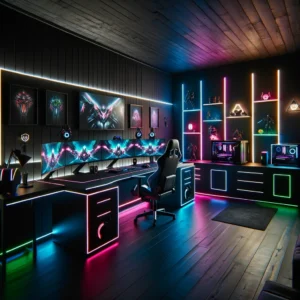
Benefits: Black is perfect for creating a focused, immersive environment. It minimizes distractions by absorbing light rather than reflecting it, which enhances the vividness of your screens and LED lights.
Best for: Players who love a high-tech, modern look and those who play visually intensive games where immersion is essential. It’s also great for gamers who use their room to watch movies or stream, providing a cinema-like atmosphere.
Blue: Calm and Focused
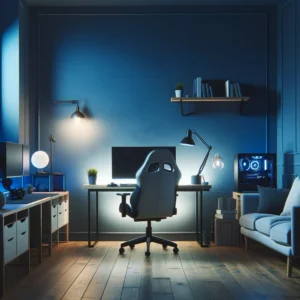
Benefits: Blue can help reduce stress and promote concentration and is known for its calming effects. Blue LED lights can brighten a space while providing a relaxing atmosphere, whereas dark color scheme blues can make a room feel more enclosed and focused.
Best for: Strategic games like chess, complex RPGs, or any gaming that requires long periods of concentration. It’s also a favorite in spaces used for work and play, as it helps maintain productivity.
Red: Energizing and Exciting
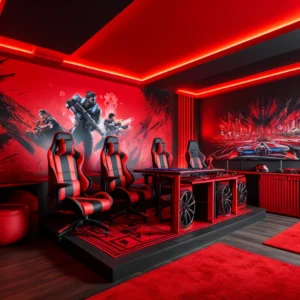
Benefits: Red is a stimulating color that can raise energy levels and excitement. It’s associated with passion and intensity, which can be motivating during gameplay.
Best for: Action-packed games, including first-person shooters and sports games where quick reactions are needed. It’s a bold choice that can make a strong style statement.
Green: Relaxing and Endurance-Friendly
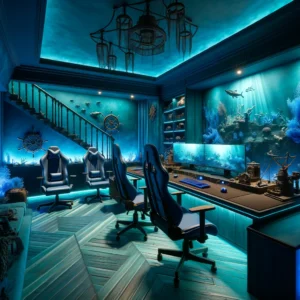
Benefits: Green is the easiest color on the eyes and can help reduce eye strain, a huge plus for gamers. It’s associated with nature and can bring a sense of tranquility to your space.
Best for Gamers who engage in marathon sessions. Whether it’s epic single-player adventures or extensive multiplayer matches, green helps create a comfortable environment that can lead to less fatigue.
Gray: Neutral and Versatile
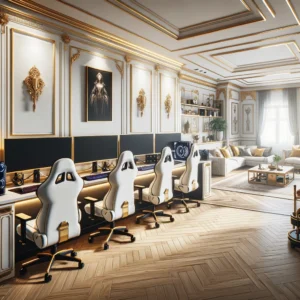
Benefits: Gray offers a sophisticated, neutral backdrop that works with any other accent colors and gaming setups. It’s perfect for those who like to change their room’s accessories or setup frequently, as it adapts well to different themes and decorations.
Best for: Streamers or those who want a professional look in their gaming space. It’s also great for those who like minimalist designs but still want some personality in their room.
Purple: Deep and Luxurious
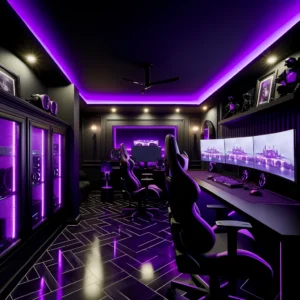
Benefits: Purple combines the calm stability of blue and the fierce energy of red, offering a balance of stimulation and serenity. It can foster creativity and luxury, making it a unique choice for a game room.
Best for: Creative gamers, such as those who enjoy designing in simulation games or storytelling in immersive RPGs. It’s also a standout choice for those who want a slightly different room.
Combinations and Themes
While solid colors are straightforward, don’t avoid combinations or themed approaches. For instance, a superhero theme might involve bold reds and blues, while a space theme could lean into dark blues, blacks, and sparkling silvers. Think about what excites you and what fits with your gaming genre or the mood you want to convey.
These colors and combinations can be adapted depending on personal taste and the specific types of games you play most often. Remember, the best color for your game room makes you feel comfortable, enhances your gaming experience, and reflects your personality.
Combining Colors for a Unique Look
Mixing colors can be daunting, but it’s entertaining once you get the hang of it. Try a gray base with accents in your favorite vibrant colors. Or, for something bold, how about black with deep red accents? Play around with color swatches and see what speaks to you.
Lighting and Paint: Enhancing Each Other
The interplay between LED strips and paint color in your game room is critical, as it can significantly affect your space’s aesthetics and functionality. Here are some insights on how to make the most of this relationship to enhance your gaming environment:
Understanding Light Reflection and Absorption
Reflective Qualities of Paint: Lighter colors tend to reflect more light, brightening up a room and making it feel larger and more open. Darker colors, meanwhile, absorb light, which can make a small space feel cozier or smaller but also more immersive. This is particularly important in a gaming room where the focus is often on screens.
Finish Matters: The finish of the paint can also affect light reflection. Glossy finishes reflect more light and can create a vibrant, energetic feel, while matte finishes absorb more light, reducing glare, which is ideal for viewing screens.
Matching Light Types with Paint Colors
Warm vs. Cool Lighting: Warm lights work well with warm paint colors like reds, oranges, and yellows, enhancing their coziness. Cool lights, on the other hand, complement blues, greens, and purples, reinforcing their calming effects.
LEDs and RGB Lighting: LED strip lights and RGB setups are popular in game rooms because they offer customizable colors that instantly change the room’s mood. These lights can dynamically contrast or complement wall colors, depending on the effect you’re looking for. Even disco lights were used
Strategic Lighting Placement
Ambient Lighting: This is the primary source of light in your room. A central overhead light can be too harsh for gaming, especially if the paint color on your walls is darker. Consider using indirect ambient lighting that can be dimmed to enhance the depth of the wall color without creating glare.
Task Lighting: Task lighting is essential for areas where you might do more than gaming, like a desk for work or a corner for reading. It should be brighter and more focused. Adjustable desk lamps or floor lamps that complement the overall lighting scheme can help illuminate specific areas without overwhelming the rest of the room.
Accent Lighting: Use accent lighting to highlight architectural features or gaming collections. This type of lighting can add depth and shadow effects, especially against darker or textured walls.
Enhancing Colors Through Lighting
Mood Enhancement: Lighting can enhance the psychological impacts of your chosen paint colors. For example, blue lighting on a blue wall can intensify feelings of calmness and focus, while red lights on a black wall can create a dynamic, energetic gaming environment.
Visual Comfort: Balancing the brightness and hue of your lights with your wall color is critical to maintaining visual comfort. Too much contrast can strain the eyes, while a harmonious balance can create a comfortable environment for long gaming sessions.
Practical Tips for Lighting and Paint Harmony
Experiment with Color Temperatures: Different bulbs have different color temperatures, measured in Kelvins. Bulbs with a lower Kelvin value emit a warmer, yellowish light, while higher Kelvin values result in a more relaxed, bluish light. Choose bulbs that will complement or neutrally balance your wall colors.
Use Dimmable and Smart Lighting: Smart lighting systems that allow you to control brightness and color can adapt your room’s ambiance to different activities and times of day, making it easy to switch between gaming, working, or relaxing.
DIY Painting Tips for Your Game Room
Painting your game room yourself can be a satisfying project that saves money and allows you to personalize your space entirely. Here are some practical tips to ensure that your DIY painting project goes smoothly and results in a professional-looking finish:
Choosing the Right Paint
Type of Paint: Opt for high-quality latex paint for walls as it’s durable, easy to clean, and quick-drying. Satin or semi-gloss finishes are ideal for game rooms because they handle humidity well and are easier to clean than flat finishes.
Color Selection: Remember that colors can look different depending on lighting, so purchase paint samples in different sizes to test on your walls. This will help you see how the color looks at different times of the day and show what an entire room will look like.
Preparing the Room
Clear the Space: Move furniture and gaming equipment from the room to the center and cover with drop cloths. Remember to protect your floors with a durable cover.
Surface Preparation: Clean the walls with mild detergent and water, repair any holes or cracks with spackle, and sand smooth any rough areas. This ensures that your paint adheres appropriately and looks soft.
Tape Edges: Use painter’s tape along baseboards, trim, and any areas where you want sharp lines. This makes a huge difference in achieving professional-looking results.
Painting Techniques
Priming: Using a primer to change a dramatic color or paint over dark colors. This will help cover the old color and make the new color pop.
Using the Right Tools: Use a high-quality roller for large areas and angled brushes for corners and edges. Investing in good tools can significantly affect the finish and ease of your painting job.
Edging First: Paint the corners and edges of the walls first. This allows you to roll the broader surfaces without worrying about over-rolling into other areas.
Even Coats: Apply the paint in even, W-shaped strokes to avoid streaking. Let the first coat dry completely before applying the second. Two coats are usually enough, but a third might be necessary for vibrant colors.
Safety Tips
Ventilation: To avoid inhaling fumes while painting, keep the room well-ventilated. Open windows and use fans to circulate air.
Protective Gear: Wear gloves, goggles, and old clothes. Paint can splatter unexpectedly, and protecting your eyes and skin is essential.
Safe Ladder Use: If you need to use a ladder to reach high places, ensure it’s stable and secure. Please stay within the ladder; it’s safer to move the ladder frequently.
Post-Painting Care
Drying Time: Allow the paint to dry completely before moving the furniture back in. This might take longer than the dry time listed on the paint can, especially in humid conditions.
Cleaning Up: Clean your brushes and rollers with warm, soapy water and wrap them in plastic or foil to reuse for touch-ups. Seal any leftover paint cans tightly to use for future touch-ups or projects.
Adding Personal Touches
Once the paint is dry, it’s time to personalize the space. Hang up your favorite wall art, decorate colorful accessories, and arrange your gaming gear or video game room ideas. Remember, this is your space to enjoy, so add those personal touches that make it uniquely yours.
By following these tips, you can achieve a great-looking game room that enhances your gaming experience and withstands the wear and tear of everyday use. Happy painting!
Final Thoughts
Choosing the right color for your game room is a powerful way to enhance your overall gaming experience. Feel free to express your personal style with your color choices. Remember, this is your domain, so make it something that reflects who you are as a gamer.
I started with a small game room; I loved the room a lot but noticed the space was getting too tight. I have many game art, a collection of card games, and game consoles. I needed a bigger space, not a large entertainment center but a room with more space.
Ready to show off your new game room?
Once you’ve transformed your space, why not share it online? Tag me in your photos—I’d love to see how you bring your gaming world to life with color!

